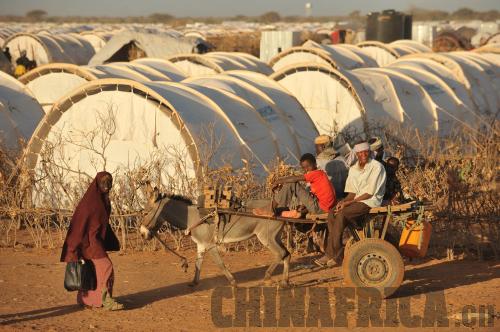| 
Vast, dusty and congested. The Dadaab refugee camp, in northeastern Kenya, is a chaotic mess of tents built of plastic and sticks. This year Dadaab is 20 years old and remains the world's largest refugee camp, originally built by the United Nations High Commissioner of Refugees (UNHCR) for 90,000 people but today accommodating over five times that number.
With insufficient medical care, food and water, disease is a constant companion to those who call the camp home - the majority fleeing from Somalia, a country embroiled in a deadly mix of conflict, persecution, drought and famine.
Somalia remains one of the worst humanitarian crises in the world and has been without a central government since 1991.
"The refugee camps in Kenya are overcrowded, have caused huge environmental degradation, have led to growing tensions with host populations and are infiltrated by extremists. This is the reality of the humanitarian and security crisis that Kenya continues to bear," Kenya's President Mwai Kibaki told a conference on Somalia held in London's Lancaster House at the end of February this year.
That Kenya is at a crossroads due to the lawless, unstable and conflict-ridden Somalia is no secret. On one hand, Kenya wants peace in Somalia, so that the refugees can return to their home.
On the other hand, the Kenya Defence Forces are in Somalia pursuing al Shabaab militants, so that the country's Transitional Federal Government (TFG) can gain a firm control. The conflict is mainly located in south and central Somalia, where the TFG, supported by African Union peacekeepers (AMISOM), is opposed by Islamist insurgents.
However, the tight budget in Kenya and the regional powerplays - Uganda, Ethiopia and Burundi would all want to share the credit for restoring peace in Somalia - are obvious constraints to a decisive action in Somalia. Kenya yielded to the regional pressure and acquiesced to send its troops to join the peacekeeping force of the African Union Mission in Somalia.
Back home, Kenya has had to grapple with how it would handle the refugees who are scattered all over the country, given the al Shabaab threat.
Dadaab unbundled
The story of Dadaab is as old as the violent and bloody civil war in Somalia. According to the UNHCR, the body that manages the complex, the first camps were put up between October 1991 and June 1992.
The Dadaab complex has five camps: Dagahaley, Hagadera, Ifo, Ifo2 East, Ifo2 West, and Kambioos. The UNHCR total people for all those camps as at February was 463,000. The Kenya government figure is 630,000.
The variance could be explained because the state is aware that not all refugees are within the camps, and that government had temporarily suspended the registration of new arrivals, which has not stopped the weekly flow of 1,000 refugees from crossing into Kenya, according to the country's Ministry of Immigration.
According to UNHCR spokesman Andrej Mahecic, the total Somali refugee population in the East Africa region is slightly over 1 million. Dadaab already has some 10,000 third-generation refugees born there to refugee parents who themselves were also born in the camp.
Mahecic spoke at the recent London meeting that sought to galvanize political and humanitarian support for the restoration of Somalia.
|